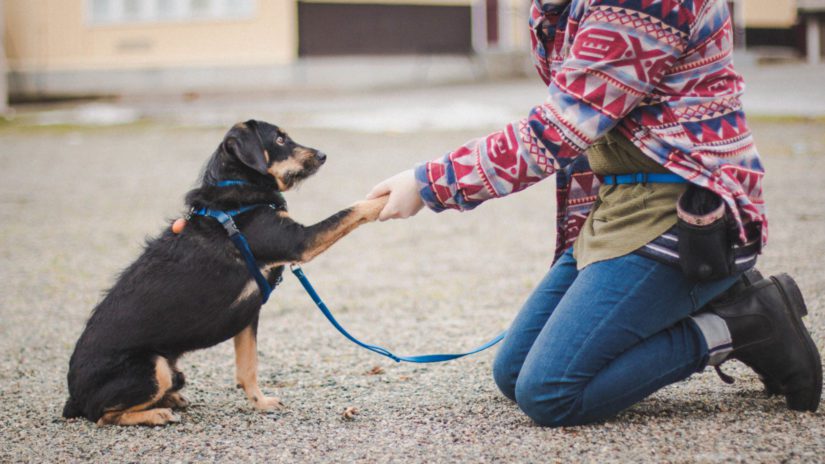Adding a dog to your family is a fun and exciting adventure. Whether your new friend is a puppy or adult, proper training is top of your mind. Things like good manners in the house, behaving well with other dogs and people, and feeling comfortable at the vet are all important skills to work on with your new dog.
Being home right now makes many things easier (particularly with house training those puppies!), but isolation and social distancing can add some challenges to your training plans. When it comes to training your new dog, here are five tips to set you up for success.

1. Proper puppy socialization matters, but your health is more important
While the thought of not properly socializing a dog with unfamiliar people and pets can seem overwhelming, your health is far more important. Respect city notices of park closures and don’t break social distancing to let people pet your new dog. There will be plenty of opportunities for friends and family to meet your new, and well-trained dog, later. What you can do during this time is teach your dog how to behave when greeting people. Dogs should not jump at or towards people for attention, and learning to sit politely is an important skill.
If you live with people, have one person be the “owner” who has the dog on a leash, and the other person be the “stranger”. The stranger should practice walking up to or past the owner and dog, and the goal is for the dog to calmly sit without barking or seeking attention. The owner can use kibble or treats to reward the dog when they sit quietly. If the dog is calm, the stranger can work on directly approaching and petting the dog, and the dog needs to sit quietly during the meet-and greet. If the dog gets too excited or is fearful, go back to just walking past the dog and owner, slowly decreasing the distance as the dog learns to sit quietly.
Is your dog a superstar at meet-and-greets? Once your dog masters the quiet meet and greet, the stranger can try wearing coats, carrying bags, an umbrella, or other objects that can be surprising to dogs. Just like before, your dog should sit quietly and not react to the stranger. If the dog is unsure of anything you try, increase the distance between stranger and dog-owner to a space where the dog can quietly sit and focus on the owner. Always set your dog up for success by training them first where they can behave and slowly work up to more challenging situations.
Do you live on your own? See tip #3 and practice all of this at a distance to others.

2. Teach foundational skills now that you can build on later
While it’s fun to have your dog learn unique tricks, basic manners are essential to having a happy dog. Dogs look up to you to be their leader, giving guidance and structure to their lives. Basic training skills such as sit, stay, down, loose leash walking, leave it, and watch me, are simple commands every dog should know. If you’ve got a new puppy or adult dog, start with teaching them the basics in a low-distraction environment. Once they master basic training in the quiet setting, move to higher distraction situations. It’s amazing how dogs can behave so well at home, yet as soon as they see a squirrel everything changes! Practicing these foundational skills with your dog now will have you ready to successfully socialize later.
An additional skill-set to work on with your dog is being properly touched and handled when visiting the vet or groomer. Have your dog sit quietly and be ok with you touching parts of their body such as the paws, ears, nose, tail, and belly. Always reward good behaviour with verbal praise and treats. If your dog doesn’t like something or shows aggression towards you or a family member when doing any of this, stop. Make note of what you were doing when the dog decided they didn’t like it, and discuss the situation with a professional trainer to get customized advice.

3. Training from a distance has many benefits.
Believe it or not, social distancing will make some parts of training easier than expected. People love dogs and will want to come meet your new friend, but oftentimes these greetings cause challenges later. Overly friendly dogs get too excited when everyone approaches, instilling behaviours such as jumping, while shy dogs aren’t ready for everyone to meet them and can become fearful later.
With social distancing, you have much more control over how your dog interacts with people. Assuming it is safe for your health and the health of others for you to go outside, work with your dog to perform the basic skills from no closer than 1.5 meters (6 feet) away. Make sure they stay relaxed next to you if someone walks by, aren’t pulling to play with other dogs on leash, are ok with bicycles, and any other outdoor distractions you can think of.

4. Make sure your dog learns to spend time alone
The ability to stay home is hugely valuable both for training and bonding with your new pet. The downside to being home 24/7 however, is that your dog may expect this to be “normal”. Believe it or not, dogs need to learn to be alone, and this is a particularly important skill to teach puppies.
When you’re home, make sure crate training is part of your routine. Start with small increments of time in the crate and gradually work up to more time. The crate should be a happy place for your dog where it gets rewards such as dinner or a stuffed KONG®. Never use a crate for punishment. Once your dog is comfortable in the crate, work on extending the time they spend as well as you leaving the room. Your dog will quickly learn that crate time is fun (when they get a yummy reward) and that it’s okay when you aren’t within eyesight.
When you do run errands, take advantage of this time to train; leave your dog at home in their crate so they do get the full experience of being alone.
Always remember to take your dog out for a potty break and exercise beforehand! This is particularly important for puppies, who need to gradually work up to being left alone. Never leave a young dog alone for more than 2-3 hours until you know they’re crate trained.
Not a fan of crates? While there are huge benefits to crate training your dog, it’s not for everyone. You can do this training with a dog pen or baby gate to prevent your dog from accessing you while you’re home. The important thing is that your dog learns being on their own is safe and fun.

5. Be patient
It can be tempting to want instant results, particularly when we have more time on our hands right now to dedicate to training the dog. Some things in life take time, and for all dogs, training is an ongoing process. Training sessions should be kept short at 5-10 minutes for young puppies and 10-30 minutes for older dogs, depending on their focus and the complexity of the task. You can do more than one training session in a day!
In fact, puppies do best with multiple, short training exercises throughout the day. Remember to always reward good behaviour with praise and treats, and don’t punish unwanted behaviours, as that’s shown to be counterproductive in the long-term.
6. Get started now!
If you have extra time at home, why not use this opportunity to work with your dog, with the help of an AnimalKind accredited trainer? While training is normally done in person, training and behaviour modification from a distance can be an excellent option for you and your pet. You can work with your dog or puppy right in your own kitchen or living room, and the trainer will teach remotely, watching and offering coaching and live demonstrations through the video screen Enroll in online training classes or virtual consulting today. Find a list of AnimalKind trainers offering virtual services at animalkind.ca. They will be happy to get started with you and your pup.
Congratulations and have fun with the new dog in your family!
More tips
How do I welcome a new dog into my home?
5 Ways to keep your dog entertained at home

